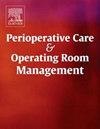选择性小儿麻醉中的喉痉挛:发病率和危险因素
IF 1
Q2 Nursing
Perioperative Care and Operating Room Management
Pub Date : 2025-08-15
DOI:10.1016/j.pcorm.2025.100543
引用次数: 0
摘要
喉痉挛是一种罕见但可能危及生命的严重事件。本研究的目的是确定喉痉挛在选择性小儿麻醉中的发生率和相关危险因素。方法在阿尔及利亚奥兰市卡纳斯特尔医院儿科麻醉科进行前瞻性单中心队列研究。它包括在2017年7月至2019年8月期间接受任何选择性手术的16岁以下患者。接受紧急手术的儿童,手术前两周内患有上呼吸道感染(URTI)的儿童,或手术前30天内哮喘发作的儿童不包括在内。喉痉挛定义为持续低氧血症,血氧饱和度(SpO2)≥90%,持续≥30 s,伴吸气和呼气喘鸣。结果分析1270例手术,发现喉痉挛12例(发生率0.9%)。平均年龄55.41±43.233个月。7例(58.33%)喉痉挛发生在觉醒期,5例(41.67%)喉痉挛发生在诱导期。主要危险因素包括:年龄小于1岁(RR: 5.6667, 95% CI: 1.744 ~ 17.779, P = 0.05)、早产史(RR: 0.161, 95% CI: 0.0181 ~ 1.233, P = 0.042)、颌面手术史(RR: 6.768, 95% CI: 1.494 ~ 33.568, P = 0.045)。多因素分析确定以下危险因素:年龄小于1年(RR: 4.888, 95% CI: 1.461 ~ 16.356, P = 0.01)和麻醉师经验小于1年(RR: 2.324, 95% CI: 1.014 ~ 5.323, P = 0.046)。该研究还揭示了喉罩气道管理的有益效果的证据。结论小儿择期麻醉中喉痉挛的增加与多种因素有关。本文章由计算机程序翻译,如有差异,请以英文原文为准。
Laryngospasm in elective pediatric anesthesia: incidence and risk factors
Background
Laryngospasm is a rare but potentially life-threatening critical event. The aim of this study was to identify the incidence and the associated risk factors of laryngospasm in elective pediatric anesthesia.
Methods
A prospective single-center cohort study was conducted in the pediatric anesthesia department at Canastel Hospital in Oran (Algeria). It included patients up to 16 years of age who underwent any elective procedure between July 2017 and August 2019. Children undergoing emergency surgery, those with an upper respiratory tract infection (URTI) within two weeks before the procedure, or those who had an asthma attack within 30 days before surgery were not included. Laryngospasm was defined as persistent hypoxemia with oxygen saturation (SpO2) <90 % for ≥30 s, with inspiratory and expiratory stridor.
Results
We analyzed 1270 procedures, identifying 12 cases of laryngospasm (incidence 0.9 %). The mean age was 55.41 ± 43.233 months. 7 (58.33 %) of cases of laryngospasm occurred during awakening phase while 5 (41.67 %) were recorded at induction. The major risk factors included: age less than one year (RR: 5.667, 95 % CI: 1.744–17.779, P = 0.05), history of prematurity (RR: 0.161, 95 % CI: 0.0181–1.233, P = 0.042), and maxillofacial surgery (RR: 6.768, 95 % CI: 1.494–33.568, P = 0.045).
The multivariate analysis determined the following risk factors: age of less than one year (RR: 4.888, 95 % CI: 1.461–16.356, P = 0.01) and anesthesiologist experience of less than one year (RR: 2.324, 95 % CI: 1.014–5.323, P = 0.046). The study also revealed evidence of the beneficial effect of laryngeal mask airway management.
Conclusion
The findings highlight increased associations of laryngospasm in elective pediatric anesthesia with multiple factors.
求助全文
通过发布文献求助,成功后即可免费获取论文全文。
去求助
来源期刊

Perioperative Care and Operating Room Management
Nursing-Medical and Surgical Nursing
CiteScore
1.30
自引率
0.00%
发文量
52
审稿时长
56 days
期刊介绍:
The objective of this new online journal is to serve as a multidisciplinary, peer-reviewed source of information related to the administrative, economic, operational, safety, and quality aspects of the ambulatory and in-patient operating room and interventional procedural processes. The journal will provide high-quality information and research findings on operational and system-based approaches to ensure safe, coordinated, and high-value periprocedural care. With the current focus on value in health care it is essential that there is a venue for researchers to publish articles on quality improvement process initiatives, process flow modeling, information management, efficient design, cost improvement, use of novel technologies, and management.
 求助内容:
求助内容: 应助结果提醒方式:
应助结果提醒方式:


